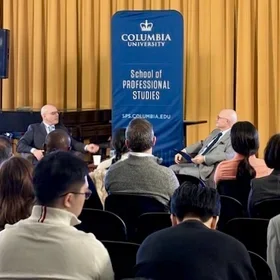By Steven Cohen, Ph.D., Director of the M.S. in Sustainability Management program, School of Professional Studies
Throughout the 19th and 20th centuries, we used innovative materials in our built environment that we came to learn were toxic. Gas pressure regulators in homes once contained a couple of ounces of highly toxic mercury. Asbestos was used in buildings due to its utility as a flame retardant. And lead pipes were used to carry water due to their strength and flexibility. All these substances proved dangerous to human health, and over the last half-century, we have replaced them in new construction with less toxic alternatives and gradually replaced them in existing buildings and infrastructure. Last week, at long last, the federal government gave utilities and governments a deadline of ten years to remove most lead pipes from our water supply system. The ban does not extend to lead pipes on private property since no one believes the current Supreme Court would allow that logical extension of EPA’s powers. Frankly, just eliminating the lead pipes in the public water supply will be difficult, expensive, and certainly fought by those opposed to all forms of government regulation.
According to a recent report by Zach Montague and Hiroko Tabuchi of the New York Times:
“Marking the 10th anniversary of the water crisis in Flint, Mich., President Biden on Tuesday gave water utilities 10 more years to replace virtually every lead pipe in the country, imposing the strictest limits to date on a neurotoxin that is particularly dangerous to infants and children… The new rule, issued by the Environmental Protection Agency, sets the most aggressive restrictions on lead in drinking water since federal standards were first set decades ago. Utilities will be required to take stock of their lead pipes and replace them over the next 10 years, a policy that four states — Illinois, Michigan, New Jersey and Rhode Island — have in place already. Lead poisoning can cause irreversible damage to the nervous system and the brain and poses a particular risk to infants and children, impairing their cognitive development and causing behavioral disorders. Service lines, the lead pipes that bring water into homes, are thought to be a major source of lead exposure for children. (Lead-based paint, sometimes found in older buildings, is another.)”
The cost of this regulation will be between $20 and $30 billion, with as much as half of that available under the bipartisan infrastructure bill. When President Biden announced the new rule, he also announced an allocation of $2.6 billion of infrastructure funding to start the process. Still, as Montague and Tabuchi report, many of the lead pipes that will remain are in the homes of people too poor to afford to replace them. A new law would be needed to require and fund that last step in the process.
Unsurprisingly, there is resistance to the rule by organizations and interest groups that do not want to spend the money needed to detoxify their operations. On a society-wide basis, the financial benefits of detoxifying our homes massively outweigh the costs of ignoring these clean-ups. The health care costs and the productivity loss of the people harmed are much higher than the seemingly high cost of clean-up. The problem is that the benefits of eliminating lead pipes accrue to a massive group of largely poor people while the costs are borne by a smaller group of wealthier interests. This is why federal subsidies are needed to get the job done. The Biden Administration is well aware of these facts, and in the press release announcing the program, observed that:
“EPA estimates that up to 9 million homes are served through legacy lead pipes across the country, many of which are in lower-income communities and communities of color, creating disproportionate lead exposure burden for these families. Eliminating lead exposure from the air people breathe, the water people drink, and the homes people live in is a crucial component of the Biden-Harris Administration’s historic commitment to advancing environmental justice. The Lead and Copper Rule Improvements establish achievable, common-sense practices which have been implemented by several states and cities. The public health and economic benefits of the final rule are estimated to be up to 13 times greater than the costs…”
While much of the impetus for environmental sustainability is shifting to the highly dynamic green private economy, this issue is an example of the critical role that can only be played by the public sector. Although a second Trump presidency will not end the transition now underway to environmental sustainability, its anti-regulatory and anti-science ideology make it unlikely that initiatives like the Biden lead-pipe rule would see the light of day.
The underlying issue here is the absence of the precautionary principle in introducing new technologies to the economy. The precautionary principle requires the testing of new technologies for negative impacts before they are introduced for use. We are only now paying the costs of the clean-up of problems that were caused by 20th-century technologies. Had we tested the health and environmental impacts of those technologies before they were introduced, we would not face these costs. The reason we do not require prior testing of new technologies is that we believe such rules will slow down the pace of innovation in our economy. That theory has never been tested, and I suspect it is mythology. In the case of pharmaceuticals, all new drugs are subjected to the precautionary principle, and there is no evidence that it has reduced the pace of new drug development. Quite the contrary. By increasing the public’s confidence in the safety of a drug, regulation helps build the market for the drug and seems to have the impact of encouraging research and development and product innovation. Big pharma has had no problem growing in the face of the “obstacle” of government regulation.
We do not know what new substances are being developed and incorporated into modern production lines and products. We have no idea of the impact of these new technologies on human and environmental health. Some of the technologies being developed to reduce greenhouse gasses, such as batteries and solar cells, include substances that we already know are toxic. At least in those cases, environmentalists are paying attention. But what about the less visible and less prominent new products being introduced every day? What will their impact be? According to the California Department of Toxic Substances Control:
“The U.S. currently has more than 80,000 chemicals in commerce. Of these, approximately 2,500 are “high production volume” (HPV) chemicals, which are manufactured at a rate of more than one million pounds annually, with nearly 45 percent of these HPV chemicals lacking adequate toxicological studies conducted to evaluate their health effects on humans and on wildlife. Further, about 2,000 new chemicals are introduced into commerce annually in the U.S., at a rate of about seven new chemicals a day. Many in the US assume that the government carefully reviewed the safety of every chemical before it is allowed on the market. However, this assumption is not correct. In fact, most of the 80,000+ chemicals registered for use today have not been tested for safety or toxicity by any government agency.”
Tomorrow’s “lead pipes” and “asbestos-lined walls” are being introduced into our economy at a ferocious rate. The chemical industry has fought regulation for decades and has largely won. Even chemicals that are known to cause harm are permitted to continue if their use generates profits. During the Biden administration, the feeble effort to test, regulate, and ban harmful chemicals showed little improvement. When a chemical, like lead, shows obvious and dramatic health impacts, we sometimes see slow and steady progress to control it. But without drama and visibility, the growing toxicity of our environment is simply ignored. As Americans focus more on wellness, fitness, and nutrition, the culture may someday be more receptive to controlling toxic chemicals. But for now, we will need to settle for incremental progress in finally getting more of the lead out of our drinking water.
Views and opinions expressed here are those of the authors, and do not necessarily reflect the official position of Columbia School of Professional Studies or Columbia University.
About the Program
The Columbia University M.S. in Sustainability Management program offered by the School of Professional Studies in partnership with the Climate School provides students cutting-edge policy and management tools they can use to help public and private organizations and governments address environmental impacts and risks, pollution control, and remediation to achieve sustainability. The program is customized for working professionals and is offered as both a full- and part-time course of study.



